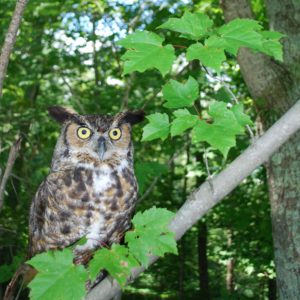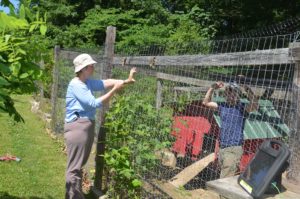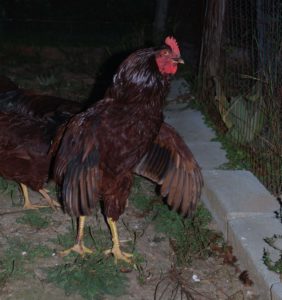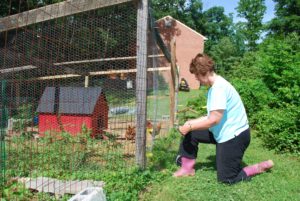On the rural southwest Virginia road where my wife, Elaine, and I live, a number of folks raise chickens. Understandably, then, it’s common for us to exchange information on how our respective flocks are doing. So, several months ago, I wasn’t surprised to receive a frantic call from a neighbor that “some hawk is eating one of my chickens.”
I quickly walked to the lady’s backyard, where I observed a red-tailed hawk finish consuming a white leghorn hen before the raptor flew away at my arrival. I wasn’t surprised at the predator’s successful raid – my neighbor doesn’t have netting over her run.

A red-tailed hawk caused this destruction. Quality netting can ward off aerial attackers.
Contrast that with what happens whenever a hawk or owl visits our backyard. Numerous times over the years, I’ve witnessed hawks perched either on our two chicken runs’ posts or in nearby trees. I’ve watched them stare into our runs – covered with netting – trying to ascertain how to enter. Instinctively, I believe, they know that their wings would’ve become entangled in the mesh if they attempted to enter. That netting is one of numerous defensive measures we’ve put into place to repel the many predators that might come to eat our chickens. Before detailing these protective devices, first let’s take a look at the rogue’s list of marauders that’ll try to devastate our – or your – flocks.
Aerial Predators

Great horned owls can attack chickens inside and outside of their runs. Quality netting can protect the birds.
Two types of aerial predators exist, the nocturnal owls and the diurnal hawks. Numerous species of owls exist in the United States; among the most widespread are the great horned, barred, barn, and screech. The first three owls are the largest members of this quartet, and thus most likely to try to raid a run. They’re also often crepuscular attackers, meaning they commonly prey at twilight time. Of course, they can also be quite active just before and after dawn.

The broad-winged hawk is just one of many members of the accipiter and buteo families of raptors.
Two major genera of hawks are the accipiters and the buteos. The former typically feature short, rounded wings and long tails, which help them maneuver, especially in wooded habitat. Two of the more common members in this genus are the Cooper’s and sharp-shinned. Four widespread members of the buteo clan are the red-tailed, red-shouldered, broad-winged, and rough-legged. In general, buteos feature broad, rounded wings and short, wide tails. They’re most at home in open country, although I’ve observed them successfully killing squirrels and chipmunks in forests.
Mammalian Predators
Although owls and hawks can certainly be a major threat to our chickens, mammalian predators present the most serious danger to fowl. Bears, coyotes, gray and red foxes, raccoons, opossums, skunks, minks, and weasels are just a few of the mammals that’ll attempt to enter a run. Of all these creatures, the mink is the one I fear the most. They can go through a 2-inch hole in wire, climb just about anything, and are excellent diggers. Minks have been known to kill every chicken within a run, but only eat a few of them. These marauders typically live near water, especially creeks, and hunt mostly at night.
Perhaps the biggest threat to our chickens, though, is a raccoon. Widespread across the Lower 48 and into Canada and Central America, coons are infamous for relishing a good chicken dinner. If you leave your henhouse door open at night, sooner or later, ringtails will pay a visit. And once they partake of an easy meal, they will return.
Defensive Measures
The easiest defense to construct is netting. However, let me emphasize not to purchase the cheap “bird” netting often used to cover trees ripe with fruit. The first time wet snow occurs, this light mesh will buckle, leaving gaping holes in your defense. Spend a little more and purchase heavy-duty plastic netting. Do this and you shouldn’t have to worry about snowfall and avian attackers.

Elaine Ingram strings netting around the perimeter of one of the runs. This netting is an effective deterrent to hawks and owls.
Next, use three types of fencing around and within the run. The strongest (and most expensive) is hardware cloth with 1/2-inch mesh. For our two runs, this galvanized, welded metal goes over henhouse windows, the door to the run, and underground around the runs’ perimeters. Hardware cloth is strong and durable. If a nocturnal predator, such as a raccoon or opossum, should enter the run, it would have an extremely difficult time breaking through a window covered with hardware cloth.

Chicken wire goes on the inside and hardware cloth on the outside.
We have both of our runs’ doors lined with hardware cloth because a door, obviously, is a major potential entry point for any predator. More importantly, though, is our placing of buried hardware cloth around the entire perimeter of both runs. Some predators, such as skunks and minks, are deft diggers and may try to enter by tunneling under our defenses. However, a creature attempting to do that in our backyard would have to tunnel for 24 inches (the length of our hardware cloth) just to reach the perimeter of the run – where, then, it would encounter another round of defensive measures.
For example, around our entire run, Elaine and I positioned pressure-treated 2x4s. We’ve anchored these boards by pounding rebars into them every few feet. Periodically, on top of the 2x4s, we placed cinder blocks and bricks for added weight and protection. Inside the run, we also placed cinder blocks around the perimeter for even more deterrence.

Bruce pounds rebar into the 2x4s running along the perimeter of his two chicken runs.
So, let’s suppose that a predator has tunneled for several hours under the hardware cloth, only to reach the weighed 2x4s. The creature then rears up and comes into contact with the most formidable part of our defenses: two solar-powered electric wires running along the entire perimeter of the two runs and the adjoining garden. One wire is about 10 inches above the ground; the other is 20 inches or so. Both emit a daunting 8-kV charge – enough electricity to give a human a substantial jolt. More than enough juice to zap a mammal weighing around 10 pounds or less.

Cinderblocks positioned along one of the walls of the chicken runs. Here, the rooster is announcing that all is good inside his world.
In fact, over the years, Elaine and I’ve seen the results of many failed entry attempts. For example, one time, after hearing anguished alarm notes, we ran to the run and witnessed the most panic-stricken chickens we’ve ever encountered. It didn’t take long for us to detect what happened. A portion of the netting had been ripped off, and long claw marks extended down one of the posts. Obviously, a black bear had attempted to enter the run. We have no doubt that the bruin turned away because it repeatedly received electric thunderbolts every time the animal contacted the wires. We often speculate, with some satisfaction, how many times the predator had to be shocked before deciding enough was enough.
It’s also been common for us on summer nights when the windows are open to hear the agonized yawps of raccoons who’ve met Mr. Sparky. And it’s not unusual for us to detect the strong smell of skunks in the morning throughout the year. They, too, must’ve tried to test the wires.
We opted for solar-powered fencing because it was easier to set up a box adjacent to the run than running electric current from our house to there. Additionally, we often lose power in the wintertime, and we wanted nonstop protection.

Elaine strings electric wire around the perimeter of the Ingram’s two runs. This wire makes for excellent defense for their chickens.
The second and third type of fencing we employ is chicken wire and 2-by-4-inch mesh 14-gauge galvanized welded wire. Separate, they both have distinct pros and cons. Elaine and I like the small openings in chicken wire but realize that its strength is lacking. The 14-gauge wire is very strong, but the openings are far too large. Any matter of creature could squeeze through it.
However, these two wires combined provide very acceptable main fencing around both our runs. From the ground to the top support, the fencing is about 6-1/2-feet tall. We utilize a different combination for the windows of each run. Inside the windows, we attach chicken wire; on the outside goes hardware cloth.
Finally, we added one little protective touch just in case a raccoon makes it inside the run some night. We replaced the latches for the henhouse doors and windows with spring latches. A coon can easily flip a regular latch; a spring latch is much more difficult to open.
Elaine and I have been raising chickens for a decade now, and we’ve never lost a bird to a predator. Consider these defensive measures to keep your chickens safe.
A Rooster’s Role in Run Defense
In football, run defense is key, and, to further the sports analogy, a rooster should be the main defensive signal caller in your game plan. We have no illusions about a rooster fighting – and winning – against a bear, owl, mink, or even a raccoon. But if a daytime predator attack occurs, a good rooster should possess the courage to give the two main chicken alarm calls.
The first is a quick, high-pitched shriek that’s emitted when aerial predators are spotted. Hens react differently to this sound, depending on whether they’re in or out of the run. If they’re outside foraging, they either flatten themselves against the ground or head for thick cover. If they’re inside the run, they sprint inside the henhouse.
For ground-bound predators, roosters and hens erupt into short, loud, repetitive clucks. Our chickens don’t usually run inside their house when they spot a ground predator. But they do flock tightly together and constantly utter in unison those nonstop clucks.













8 Comments
Hi, In Australia we’re luckily to have few of the predators you have, enough aerial hawks and eagles, but really only Tasmanian devils ( only in Tasmania- an island), snakes, (not much you can do about them really, except don’t encourage rats), goannas ( big lizards) and foxes. also stray dogs and cats. However our lack of big meanies also doesn’t stop us from erecting proper protection. It has cyclone fencing ( like the type used for school or keep- out fencing, usually with barbed or razor wire on top). You can climb it but not get through it. It extends 70 cm down into the ground. Lined with 1o mm ( just under 1/2″) grid avery mesh to a metre off the ground.The roof is made of weldmesh, what you call welded galvanised wire, with 20mm squares. Their house has a concrete floor, is made from refrigerator panels, and apart from designed in, weldmesh covered ventilation, airtight. They are manually locked in at night. We would not be without a dog to guard them in the daytime when they free range, just too many foxes. I planted my block with lots of trees and bushes- when there’s an eagle above, not a chook in sight! Half measures are really just a matter of time, it’s not worth it. Happy chooking everyone
Thank you for a fascinating explanation of how such things work in Australia.
Nite Guard solar lights are a must in our Fl woodlands. Protected our flock for years. Last night our neighbor lost all but 2 chickens with one expected to not make it. She borrowed some of our nite guards to start a defensive barrier before replacing hers. Also we used nylon bird netting on an 80 foot run, during hurricane Michael two trees fell in the run without breaking the netting.
The nylon netting sounds like it did the job.
I also raise chickens in Virginia and I’m glad I came across your website. Lots of good information. Thank you.
Claire, thanks for your comments. My wife and I live in Botetourt County, Virginia, and we have lots of avian and mammal predators.
For netting on top of the run, a plastic grid material call geo grid is what I use. It is 13 feet x 300 feet at a cost of about $380 dollars. It is very durable and somewhat ridged. If you fasten it good in a grid pattern of 13×15 feet it could support a 200 pound man.
Odie,
Thanks for the note. Quality protection often is not cheap, but I think it is worth the cost in the long run and for keeping our chickens safe. After all, starting over after you have lost your flock is expensive and heart breaking.